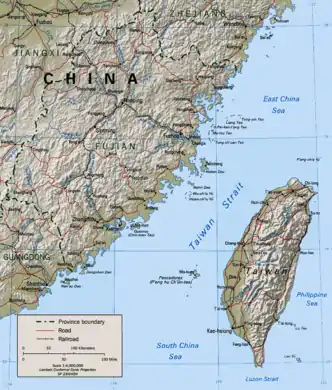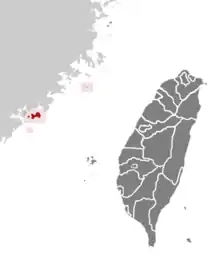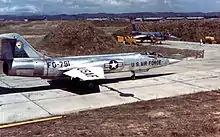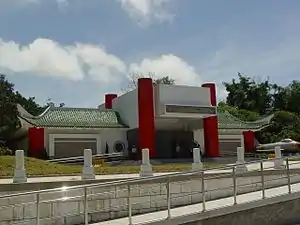Second Taiwan Strait Crisis
The Second Taiwan Strait Crisis, also called the 1958 Taiwan Strait Crisis, was a conflict that took place between the People's Republic of China (PRC) and the Republic of China (ROC). In this conflict, the PRC shelled the islands of Kinmen (Quemoy) and the Matsu Islands along the east coast of mainland China (in the Taiwan Strait) to "liberate" Taiwan from the Chinese Nationalist Party, also known as the Kuomintang (KMT); and to probe the extent of the United States defense of Taiwan's territory. A naval battle also took place around Dongding Island when the ROC Navy repelled an attempted amphibious landing by the PRC Navy.
| Second Taiwan Strait Crisis 八二三砲戰 | |||||||
|---|---|---|---|---|---|---|---|
| Part of the Cold War | |||||||
 Taiwan Strait | |||||||
| |||||||
| Belligerents | |||||||
|
|
| ||||||
| Commanders and leaders | |||||||
|
|
| ||||||
| Strength | |||||||
|
|
| ||||||
| Casualties and losses | |||||||
|
440 ROC troops killed and missing[1] 1 Landing Ship Medium sunk, 1 Landing Ship Tank damaged in the naval battle of Dongding Island |
460 PRC troops killed and wounded Several ships sunk and several more damaged in the naval battle of Dongding Island | ||||||
| Second Taiwan Strait Crisis | |||||||||||
|---|---|---|---|---|---|---|---|---|---|---|---|
| Traditional Chinese | 八二三炮戰 | ||||||||||
| Simplified Chinese | 八二三炮战 | ||||||||||
| |||||||||||
Overview

The conflict was a continuation of the Chinese Civil War and First Taiwan Strait Crisis. The Republic of China (ROC) had begun to build military installations on the island of Kinmen (Quemoy) and the Matsu archipelago. The Chinese People's Liberation Army (PLA) began firing artillery at both Kinmen and some of the nearby Matsu islands.
On August 24 and 25, 1958 Chinese Communist and Chinese Nationalist forces clashed in the vicinity of Dongding Island, which the Nationalist troops controlled. The action was seen as an attempt by the communists to land on the island. This was the only naval and amphibious landing action during the crisis. The communist forces were repelled from taking the island.[3][4][5][6] The action has also been seen as an attempt to draw Nationalist forces away from other areas.[7]
{...}on the 24th two night naval engagements took place near Quemoy. The clashes resulted from a Chinese Communist attempt at landing on the small island of Tung-Ting in the Quemoy complex. The first attack involved four Chinese Communist gunboats and six small landing craft while the second involved five Chinese Communist gunboats and thirty motorized junks. According to the GRC Ministry of National Defense, several enemy ships were sunk and the attack was driven off by seven Chinese Nationalist Patrol craft. The GRC lost one LSM (landing craft, mechanized) and had one LST (landing ship, tank) damaged. Prior to September 3, when they were advised of U. S. escort plans, the Nationalists made five attempts to land an LST with troop replacements and several ships. These efforts were turned back by Chinese Communist PT boats and artillery fire.[4]
The American Eisenhower Administration responded to the request for aid from the ROC according to its obligations in the ROC-United States mutual defense treaty that had been ratified in 1954. President Dwight D. Eisenhower ordered the reinforcement of the U.S. Navy Seventh Fleet in the area, and he ordered American naval vessels to help the Nationalist Chinese government to protect the supply lines to the islands. In addition, the U.S. Air Force deployed F-100D Super Sabres, F-101C Voodoos, F-104A Starfighters, and B-57B Canberras to Taiwan to demonstrate support for the republic. The F-104s were disassembled and airlifted to Taiwan in C-124 Globemaster II transport aircraft, marking the first time such a method was used to move fighter aircraft over a long distance.[8]
_underway_during_1958_Taiwan_Strait_Crisis.JPG.webp)

Also, under a secret effort called "Operation Black Magic", the U.S. Navy modified some of the F-86 Sabre fighters of the Nationalist Chinese Air Force with its newly developed early AIM-9 Sidewinder air-to-air missiles. These missiles gave the Nationalist Chinese pilots a decisive edge over the Chinese Communists' Soviet-made MiG-15 and MiG-17 fighters in the skies over the Matsu Islands and the Taiwan Strait. The Nationalist Chinese pilots used the Sidewinder missiles to score numerous kills on People's Liberation Army Air Force (PLAAF) MiG aircraft. The operation suffered blowback when one missile lodged in a MiG-17 without exploding, to be removed after landing and reverse-engineered into the Soviet K-13.
The US Army's contribution reinforced the strategic air defense capability of the Republic of China. A provisional Nike missile battalion was organized at Fort Bliss, TX, and sent via USMTS USS General J. C. Breckinridge to Nationalist China. The 2nd Missile Battalion was augmented with detachments of signal, ordnance and engineers, totaling some 704 personnel.
Twelve long-range 203 mm (8.0 in) M115 howitzer artillery pieces and numerous 155 mm howitzers were transferred from the U.S. Marine Corps to the Army of the Nationalist China. These were sent west to Kinmen Island to gain superiority in the artillery duel back and forth over the straits there.
Soon, the Soviet Union dispatched its foreign minister, Andrei Gromyko, to Beijing to discuss the actions of the PLA and the PLAAF, with advice of caution to the Communist Chinese.
On September 22, 1958, the Sidewinder missile was used for the first time in air-to-air combat as 32 Republic of China F-86s clashed with 100 PLAAF MiGs in a series of aerial engagements. Numerous MiGs were shot down by Sidewinders, the first "kills" to be scored by air-to-air missiles in combat.[9]
Soon, the People's Republic of China was faced with a stalemate, as the PLA's artillerymen had run out of artillery shells. The Communist Chinese government announced a large decrease in bombardment levels on October 6, 1958.
U.S. Marine Corps Marine Air Group 11 stationed at NAS Atsugi, Japan was sent to Taiwan in August and landed at Kaohsiung, Taiwan and moved via trucks to Ping Tung Air Base about 40 kilometres (25 mi) north of Kaohsiung. They remained there, conducting air operations from the WWII Japanese air strip until sometime in the spring of 1959 when they returned to Atsugi. They were joined at Ping Tung by a reinforced rifle company from the Ninth Marines based on Okinawa.
Aftermath

Afterwards, both sides continued to bombard each other with shells containing propaganda leaflets on alternate days of the week. This strange informal arrangement continued until the normalization of diplomatic relations between the United States and the Communist People's Republic of China in 1979. The timed shelling created little damage and casualties; it was mainly aimed at military compounds and artillery pieces.
On August 23, 2019, the sixty-first anniversary of the beginning of the Second Taiwan Strait Crisis, President Tsai Ing-wen visited the Taiwushan Martyrs' Shrine (太武山忠烈祠) where she placed flowers and offered incense.[10]
See also
- First Taiwan Strait Crisis
- Third Taiwan Strait Crisis
- List of battles over Kinmen
- Chinese Civil War
- Republic of China Armed Forces
- Kinmen knife
- Dongding Island
Further reading
- Bush, R. & O'Hanlon, M. (2007). A War Like No Other: The Truth About China's Challenge to America. Wiley. ISBN 0-471-98677-1
- Bush, R. (2006). Untying the Knot: Making Peace in the Taiwan Strait. Brookings Institution Press. ISBN 0-8157-1290-1
- Carpenter, T. (2006). America's Coming War with China: A Collision Course over Taiwan. Palgrave Macmillan. ISBN 1-4039-6841-1
- Cole, B. (2006). Taiwan's Security: History and Prospects. Routledge. ISBN 0-415-36581-3
- Copper, J. (2006). Playing with Fire: The Looming War with China over Taiwan. Praeger Security International General Interest. ISBN 0-275-98888-0
- Federation of American Scientists et al. (2006). Chinese Nuclear Forces and U.S. Nuclear War Planning
- Gill, B. (2007). Rising Star: China's New Security Diplomacy. Brookings Institution Press. ISBN 0-8157-3146-9
- Shirk, S. (2007). China: Fragile Superpower: How China's Internal Politics Could Derail Its Peaceful Rise. Oxford University Press. ISBN 0-19-530609-0
- Tsang, S. (2006). If China Attacks Taiwan: Military Strategy, Politics and Economics. Routledge. ISBN 0-415-40785-0
- Tucker, N.B. (2005). Dangerous Strait: the U.S.-Taiwan-China Crisis. Columbia University Press. ISBN 0-231-13564-5
- Watry, David M. Diplomacy at the Brink: Eisenhower, Churchill, and Eden in the Cold War. Baton Rouge: Louisiana State University Press, 2014.
References
Citations
- Maritime Taiwan: Historical Encounters with the East and the West by Shih-Shan Henry Tsai. Page 189. Published 2009
- 教育部重編國語辭典修訂本 (in Chinese). Retrieved 16 September 2019.
字詞 【八二三炮戰】 注音 ㄅㄚ ㄦˋ ㄙㄢ ㄆㄠˋ ㄓㄢˋ 漢語拼音 bā èr sān pào zhàn
- TAIWAN STRAITS. CIA. 27 August 1958.
Nationalists{...}claim to have driven off "invasion fleet" headed for Tungting Island.
- The 1958 Taiwan Straits Crisis_ A Documented History. 1975.
- DTIC ADA234362: Use of Naval Force in Crises: A Theory of Stratified Crisis Interaction. Volume 2. December 1988.
- 1958 Awake. 8 October 1958.
- 八二三砲戰60週年(四)824海戰 東碇島曾開火. 22 August 2018.
- Davies, Peter E. (2014). F-104 Starfighter Units in Combat. Great Britain: Osprey Publishing. pp. 22–23. ISBN 978-1-78096-313-6.
- Sidewinder AIM-9. US Naval Academy 2012. Retrieved 21 November 2017.
- 陳冠霖 (24 August 2019). 823祭拜先烈 總統蔡英文:勿忘823精神. Kinmen Daily News (in Chinese). Retrieved 21 September 2019.
Sources
- Chen Jian. (2001). Mao's China and the Cold War - Beijing and the Taiwan Strait Crisis of 1958. The University of North Carolina Press.
- http://www.generals.dk/general/Qiu_Qing-quan/_/China.html
- Ministry of National Defense, R.O.C.
- US Naval War College
- https://web.archive.org/web/20090326011824/http://cgsc.leavenworth.army.mil/carl/download/csipubs/bjorge_huai.pdf
External links
| Wikisource has original text related to this article: |
- http://www.globalsecurity.org/military/ops/quemoy_matsu-2.htm
- Mao Zedong's handling of the Taiwan Straits Crisis of 1958
- Khrushchev's Nuclear Promise to Beijing During the 1958 Crisis
- First and Second Taiwan Strait Crisis, Quemoy and Matsu Islands of Taiwan from the Cold War Museum
- The Communist Threat in the Taiwan Area Contemparary US government reaction
- YouTube - Taiwan After WW2 | US Army & Republic of China Army Prepare for War with China | Documentary